Super-Supportive Corporate Social Responsibility Behaviors in China’s Construction Enterprises
Abstract
1. Introduction
2. Literature Review and Theoretical Foundation
2.1. Rethinking CSR Constructs
2.2. Definitions of Super-Supportive CSR Behaviors
2.3. Attributes of SSCBs
3. Research Methods
3.1. Samples
3.2. CSR Behavior Identification
3.3. Text Mining
3.4. Association Rule Mining
4. Results of Data Analysis
4.1. Identifying Main CSR Behaviors in Construction
4.2. Examining Super-Supportive CSR Behaviors
- min_support = 0.6 and min_confidence = 0.8/0.9 generated 47,355 and 22,829 rules, respectively.
- min_support = 0.7 and min_confidence = 0.8/0.9 generated 2052 and 1138 rules.
- min_support = 0.8 and min_confidence = 0.8/0.9 generated 126 and 105 rules.
4.3. Exploring SSCBs’ Relationships
5. Findings and Discussion
5.1. Super-Supportive CSR Behaviors
5.2. Different Positions of SSCBs in Relationships
5.3. From Individual to Combined SSCBs
6. Conclusions
Supplementary Materials
Author Contributions
Funding
Data Availability Statement
Conflicts of Interest
Abbreviations
| CSR | Corporate social responsibility |
| SSCSR | Super-supportive CSR behaviors |
| GRI 4.0 | Global Reporting Initiative 4.0 |
| CASS-CSR4.0 | Compiling Chinese Corporate Social Responsibility Reports |
| TP, FP, FN, TN | T: true; F: false; N: negative; P: positive |
| RHS | Right-hand side |
| LHS | Left-hand side |
| E, W, C, P, Q, G, R | E: environment preservation; W: workers’ interest; C: well-being of local communities; P: good partnership; Q: safe construction and quality; G: corporate governance; R: responsibility management |
References
- Goyal, P.; Kumar, D. Modeling the CSR barriers in manufacturing industries. Benchmarking 2017, 24, 1871–1890. [Google Scholar] [CrossRef]
- Aguinis, H.; Rupp, D.E.; Glavas, A. Corporate social responsibility and individual behaviour. Nat. Hum. Behav. 2024, 8, 219–227. [Google Scholar] [CrossRef]
- Abbas, J. Does the nexus of corporate social responsibility and green dynamic capabilities drive firms toward green technological innovation? The moderating role of green transformational leadership. Technol. Forecast. Soc. Change 2024, 208, 123698. [Google Scholar] [CrossRef]
- Abbas, J. From corporate social responsibility to human social responsibility: A pathway for a sustainable society. J. Clean. Prod. 2025, 494, 144979. [Google Scholar] [CrossRef]
- International Organization for Standardization (ISO). The International Organization for Standardization (ISO) 2024 Survey; ISO: Geneva, Switzerland, 2025. [Google Scholar]
- WBCSD. Corporate Social Responsibility: Making Good Business Sense; World Business Council for Sustainable Development: Geneva, Switzerland, 2000. [Google Scholar]
- Jamali, D. A stakeholder approach to corporate social responsibility: A fresh perspective into theory and practice. J. Bus. Ethics 2008, 82, 213–231. [Google Scholar] [CrossRef]
- Mcwilliams, A.; Siegel, D. Corporate social responsibility and financial performance: Correlation or misspecification? Acad. Manag. Rev. 2000, 26, 603–609. [Google Scholar] [CrossRef]
- ISO 26000; Guidance on Social Responsibility. The International Organization for Standardization: Geneva, Switzerland, 2010.
- García-Piqueres, G.; García-Ramos, R. Complementarity between CSR dimensions and innovation: Behaviour, objective or both? Eur. Manag. J. 2022, 40, 475–489. [Google Scholar] [CrossRef]
- Schweiger, S.A.; Stettler, T.R.; Baldauf, A.; Zamudio, C. The complementarity of strategic orientations: A meta-analytic synthesis and theory extension. Strateg. Manag. J. 2019, 40, 1822–1851. [Google Scholar] [CrossRef]
- Jiang, W.; Wong, J.K.W. Key activity areas of corporate social responsibility (CSR) in the construction industry: A study of China. J. Clean. Prod. 2016, 113, 850–860. [Google Scholar] [CrossRef]
- Zhao, Z.Y.; Zhao, X.J.; Davidson, K.; Zuo, J. A corporate social responsibility indicator system for construction enterprises. J. Clean. Prod. 2012, 29–30, 277–289. [Google Scholar] [CrossRef]
- Zhang, Q.; Oo, B.L.; Lim, B.T.-H. Key practices and impact factors of corporate social responsibility implementation: Evidence from construction firms. Eng. Constr. Archit. Manag. 2022; ahead-of-print. [Google Scholar]
- Dang, X.; Wang, M.; Deng, X.; Mao, H.; He, P. What affects the corporate social responsibility practices of Chinese international contractors considering dynamic interactions? A hybrid structural equation modeling–fuzzy cognitive map approach. Eng. Constr. Archit. Manag. 2024; ahead-of-print. [Google Scholar]
- Lin, X.; Ho, C.M.F.; Shen, G.Q.P. Research on corporate social responsibility in the construction context: A critical review and future directions. Int. J. Constr. Manag. 2018, 18, 394–404. [Google Scholar] [CrossRef]
- Maqbool, S.; Zameer, M.N. Corporate social responsibility and financial performance: An empirical analysis of Indian banks. Future Bus. J. 2018, 4, 84–93. [Google Scholar] [CrossRef]
- Xie, L.; Xu, T.; Le, Y.; Chen, Q.; Xia, B.; Skitmore, M. Understanding the CSR awareness of large construction enterprises in China. Adv. Civ. Eng. 2020, 2020, 8866511. [Google Scholar] [CrossRef]
- Zhang, Q.; Oo, B.L.; Lim, B.T.H. Corporate social responsibility practices by leading construction firms in China: A case study. Int. J. Constr. Manag. 2022, 22, 1420–1431. [Google Scholar] [CrossRef]
- Lin, X.; McKenna, B.; Ho, C.M.F.; Shen, G.Q.P. Stakeholders’ influence strategies on social responsibility implementation in construction projects. J. Clean. Prod. 2019, 235, 348–358. [Google Scholar] [CrossRef]
- Zeng, X.; Momin, M.; Nurunnabi, M. Photo disclosure in human rights issues by fortune companies: An impression management perspective. Sustain. Account. Manag. Policy J. 2022, 13, 568–599. [Google Scholar] [CrossRef]
- Chang, R.D.; Zuo, J.; Zhao, Z.Y.; Soebarto, V.; Lu, Y.J.; Zillante, G.; Gan, X.L. Sustainability attitude and performance of construction enterprises: A China study. J. Clean. Prod. 2018, 172, 1440–1451. [Google Scholar] [CrossRef]
- Liao, P.C.; Xia, N.N.; Wu, C.L.; Zhang, X.L.; Yeh, J.L. Communicating the corporate social responsibility (CSR) of international contractors: Content analysis of CSR reporting. J. Clean. Prod. 2017, 156, 327–336. [Google Scholar] [CrossRef]
- Wu, C.L.; Fang, D.P.; Liao, P.C.; Xue, J.W.; Li, Y.; Wang, T. Perception of corporate social responsibility: The case of Chinese international contractors. J. Clean. Prod. 2015, 107, 185–194. [Google Scholar] [CrossRef]
- Turker, D. Measuring corporate social responsibility: A scale development study. J. Bus. Ethics 2009, 85, 411–427. [Google Scholar] [CrossRef]
- Bowen, H.R. Social Responsibility of The Businessman; Harper: New York, NY, USA, 1953. [Google Scholar]
- Sheehy, B. Defining CSR: Problems and solutions. J. Bus. Ethics 2015, 131, 625–648. [Google Scholar] [CrossRef]
- Carroll, A.B. The pyramid of corporate social responsibility: Toward the moral management of organizational stakeholders. Bus. Horiz. 1991, 34, 39–48. [Google Scholar] [CrossRef]
- Heijden, A.V.D.; Driessen, P.P.J.; Cramer, J.M. Making sense of Corporate Social Responsibility: Exploring organizational processes and strategies. J. Clean. Prod. 2010, 18, 1787–1796. [Google Scholar] [CrossRef]
- Freeman, R.E. Strategic Management: A Stakeholder Approach; Cambridge University Press: Pitman, NJ, USA; Boston, MA, USA, 1984. [Google Scholar]
- Becchetti, L.; Ciciretti, R.; Hasan, I.; Kobeissi, N. Corporate social responsibility and shareholder’s value. J. Bus. Res. 2012, 65, 1628–1635. [Google Scholar] [CrossRef]
- Linnenluecke, M.K.; Russell, S.V.; Griffiths, A. Subcultures and sustainability practices: The impact on understanding corporate sustainability. Bus. Strategy Environ. 2009, 18, 432–452. [Google Scholar] [CrossRef]
- Wan-Jan, W.S. Defining corporate social responsibility. J. Public Aff. 2010, 6, 176–184. [Google Scholar] [CrossRef]
- Lichtenstein, S.; Badu, E.; Owusu-Manu, D.G.; Edwards, D.J.; Holt, G.D. Corporate social responsibility architecture and project alignments: A study of the Ghanaian construction industry. J. Eng. 2013, 11, 334–353. [Google Scholar] [CrossRef]
- Carroll, A.B. A three-dimensional conceptual model of corporate performance. Acad. Manag. Rev. 1979, 4, 479–505. [Google Scholar] [CrossRef]
- Lockett, A.; Moon, J.; Visser, W. Corporate Social Responsibility in Management Research: Focus, Nature, Salience and Sources of Influence. J. Manag. Stud. 2006, 43, 115–136. [Google Scholar] [CrossRef]
- Carroll, A.B.; Shabana, K.M. The Business Case for Corporate Social Responsibility: A Review of Concepts, Research and Practice. Int. J. Manag. Rev. 2010, 12, 85–105. [Google Scholar] [CrossRef]
- Aguinis, H.; Glavas, A. What we know and don’t know about corporate social responsibility: A review and research agenda. J. Manag. 2012, 38, 932–968. [Google Scholar] [CrossRef]
- Barnett, M.L. The Business Case for Corporate Social Responsibility: A Critique and an Indirect Path Forward. Bus. Soc. 2019, 58, 167–190. [Google Scholar] [CrossRef]
- Barney, J.B. Why resource-based theory’s model of profit appropriation must incorporate a stakeholder perspective. Strateg. Manag. J. 2018, 39, 3305–3325. [Google Scholar] [CrossRef]
- Wang, H.; Lu, W.; Ye, M.; Chau, K.W.; Zhang, X. The curvilinear relationship between corporate social performance and corporate financial performance: Evidence from the international construction industry. J. Clean. Prod. 2016, 137, 1313–1322. [Google Scholar] [CrossRef]
- Close, R.; Loosemore, M. Breaking down the site hoardings: Attitudes and approaches to community consultation during construction. Constr. Manag. Econ. 2014, 32, 816–828. [Google Scholar] [CrossRef]
- Frynas, J.G.; Yamahaki, C. Corporate social responsibility: Review and roadmap of theoretical perspectives. Bus. Ethics: A Eur. Rev. 2016, 25, 258–285. [Google Scholar] [CrossRef]
- DiMaggio, P.J.; Powell, W.W. The Iron Cage Revisited: Institutional Isomorphism and Collective Rationality in Organizational Fields. Am. Sociol. Rev. 1983, 48, 147–160. [Google Scholar] [CrossRef]
- Gao-Zeller, X.; Li, X.; Yang, F.; Zhu, W. Driving Mechanism of CSR Strategy in Chinese Construction Companies based on Neo-Institutional Theory. Ksce J. Civ. Eng. 2019, 23, 1939–1951. [Google Scholar] [CrossRef]
- Olanipekun, A.O.; Omotayo, T.; Saka, N. Review of the use of corporate social responsibility (CSR) tools. Sustain. Prod. Consum. 2021, 27, 425–435. [Google Scholar] [CrossRef]
- Zhang, Q.; Oo, B.L.; Lim, B.T.H. Drivers, motivations, and barriers to the implementation of corporate social responsibility practices by construction enterprise: A review. J. Clean. Prod. 2019, 210, 563–584. [Google Scholar] [CrossRef]
- Global Reporting Initiative (GRI). G4 Sustainability Reporting Guidelines: Reporting Principles and Standard Disclosures; Global Reporting Initiative: Amsterdam, The Netherlands, 2013. [Google Scholar]
- GB/T 36001-2015; Guidelines for the Preparation of Social Responsibility Reports. Standardization Administration of China (SAC): Beijing, China, 2015.
- Mikolov, T.; Chen, K.; Corrado, G.; Dean, J. Efficient estimation of word representations in vector space. arXiv 2013, arXiv:1301.3781. [Google Scholar] [CrossRef]
- Fan, S.; Kong, D.; Lu, J.; Yu, H. Does investor communication improve corporate social responsibility? A machine learning-based textual analysis. China J. Account. Res. 2024, 17, 100370. [Google Scholar] [CrossRef]
- Ye, M.; Lu, W.; Flanagan, R.; Chau, K.W. Corporate social responsibility ‘glocalisation’: Evidence from the international construction business. Corp. Soc. Responsib. Environ. Manag. 2020, 27, 655–669. [Google Scholar] [CrossRef]
- Agrawal, R.; Imieliński, T.; Swami, A. Mining association rules between sets of items in large databases. In Proceedings of the 1993 ACM SIGMOD International Conference on Management of Data, Washington, DC, USA, 25–28 May 1993; Association for Computing Machinery: New York, NY, USA; pp. 207–216. [Google Scholar]
- Borgelt, C. Frequent item set mining. WIREs Data Min. Knowl. Discov. 2012, 2, 437–456. [Google Scholar] [CrossRef]
- Too, E.G.; Weaver, P. The management of project management: A conceptual framework for project governance. Int. J. Proj. Manag. 2014, 32, 1382–1394. [Google Scholar] [CrossRef]
- Loosemore, M.; Lim, B.T.H.; Ling, F.Y.Y.; Zeng, H.Y. A comparison of corporate social responsibility practices in the Singapore, Australia and New Zealand construction industries. J. Clean. Prod. 2018, 190, 149–159. [Google Scholar] [CrossRef]
- Petrovic-Lazarevic, S. The development of corporate social responsibility in the Australian construction industry. Constr. Manag. Econ. 2008, 26, 93–101. [Google Scholar] [CrossRef]
- Daily, C.; Dalton, D.; Cannella, A. Introduction to special topic forum corporate governance: Decades of dialogue and data. Acad. Manage. Rev. 2003, 28, 371–382. [Google Scholar] [CrossRef]
- Oppong, G.D.; Chan, A.P.C.; Dansoh, A. A review of stakeholder management performance attributes in construction projects. Int. J. Proj. Manag. 2017, 35, 1037–1051. [Google Scholar] [CrossRef]
- Wang, L.; Zhang, P.; Ma, L.; Cong, X.; Skibniewski, M.J. Developing a corporate social responsibility framework for sustainable construction using partial least squares structural equation modeling. Technol. Econ. Dev. Econ. 2020, 26, 186–212. [Google Scholar] [CrossRef]
- Guo, H.; Lu, W. The inverse U-shaped relationship between corporate social responsibility and competitiveness: Evidence from Chinese international construction companies. J. Clean. Prod. 2021, 295, 126374. [Google Scholar] [CrossRef]
- Maignan, I.; Hillebrand, B.; McAlister, D. Managing Socially-Responsible Buying: How to Integrate Non-economic Criteria into the Purchasing Process. Eur. Manag. J. 2002, 20, 641–648. [Google Scholar] [CrossRef]
- Loosemore, M.; Lim, B.T.H. Mapping corporate social responsibility strategies in the construction and engineering industry. Constr. Manag. Econ. 2018, 36, 67–82. [Google Scholar] [CrossRef]
- Bevan, E.A.M.; Yung, P. Implementation of corporate social responsibility in Australian construction SMEs. Eng. Constr. Archit. Manag. 2015, 22, 295–311. [Google Scholar] [CrossRef]
- Li, X.; Gao-Zeller, X.; Rizzuto, T.E.; Yang, F. Institutional pressures on corporate social responsibility strategy in construction corporations: The role of internal motivations. Corp. Soc. Responsib. Environ. Manag. 2019, 26, 721–740. [Google Scholar] [CrossRef]
- Lu, W.; Ye, M.; Flanagan, R.; Ye, K. Corporate Social Responsibility Disclosures in International Construction Business: Trends and Prospects. J. Constr. Eng. Manag. 2016, 142, 04015053. [Google Scholar] [CrossRef]
- Zeng, S.X.; Ma, H.Y.; Lin, H.; Zeng, R.C.; Tam, V.W.Y. Social responsibility of major infrastructure projects in China. Int. J. Proj. Manag. 2015, 33, 537–548. [Google Scholar] [CrossRef]
- Barthorpe, S. Implementing corporate social responsibility in the UK construction industry. Prop. Manag. 2010, 28, 4–17. [Google Scholar] [CrossRef]
- Alzahrani, J.I.; Emsley, M.W. The impact of contractors’ attributes on construction project success: A post construction evaluation. Int. J. Proj. Manag. 2013, 31, 313–322. [Google Scholar] [CrossRef]
- Montella, A. Identifying crash contributory factors at urban roundabouts and using association rules to explore their relationships to different crash types. Accid. Anal. Prev. 2011, 43, 1451–1463. [Google Scholar] [CrossRef]
- Loor Zambrano, H.Y.; Santos-Roldán, L.; Palacios-Florencio, B. Employee Trust and Internal Motivation: Its Mediating Role Between Corporate Social Responsibility and Satisfaction With the Job Itself. Corp. Soc. Responsib. Environ. Manag. 2025, 32, 7081–7101. [Google Scholar] [CrossRef]
- Khan, H.S.U.D.; Guangsheng, Y.; Chughtai, M.S.; Cristofaro, M. Effect of supervisor-subordinate Guanxi on employees work behavior: An empirical dynamic framework. J. Innov. Knowl. 2023, 8, 100360. [Google Scholar] [CrossRef]
- Carroll, A.B. Corporate Social Responsibility: Evolution of a Definitional Construct. Bus. Soc. 1999, 38, 268–295. [Google Scholar] [CrossRef]
- Porter, M.E.; Kramer, M.R. Strategy and society: The link between competitive advantage and corporate social responsibility. Harv. Bus. Rev. 2007, 84, 78–92, 163. [Google Scholar]
- Dahlsrud, A. How corporate social responsibility is defined: An analysis of 37 definitions. Corp. Soc. Responsib. Environ. Manag. 2008, 15, 1–13. [Google Scholar] [CrossRef]
- Norman, W.; MacDonald, C. Getting to the Bottom of “Triple Bottom Line”. Bus. Ethics Q. 2004, 14, 243–262. [Google Scholar] [CrossRef]
- Awaysheh, A.; Heron, R.A.; Perry, T.; Wilson, J.I. On the relation between corporate social responsibility and financial performance. Strateg. Manag. J. 2020, 41, 965–987. [Google Scholar] [CrossRef]
- Branco, M.C.; Rodrigues, L.L. Corporate Social Responsibility and Resource-Based Perspectives. J. Bus. Ethics 2006, 69, 111–132. [Google Scholar] [CrossRef]

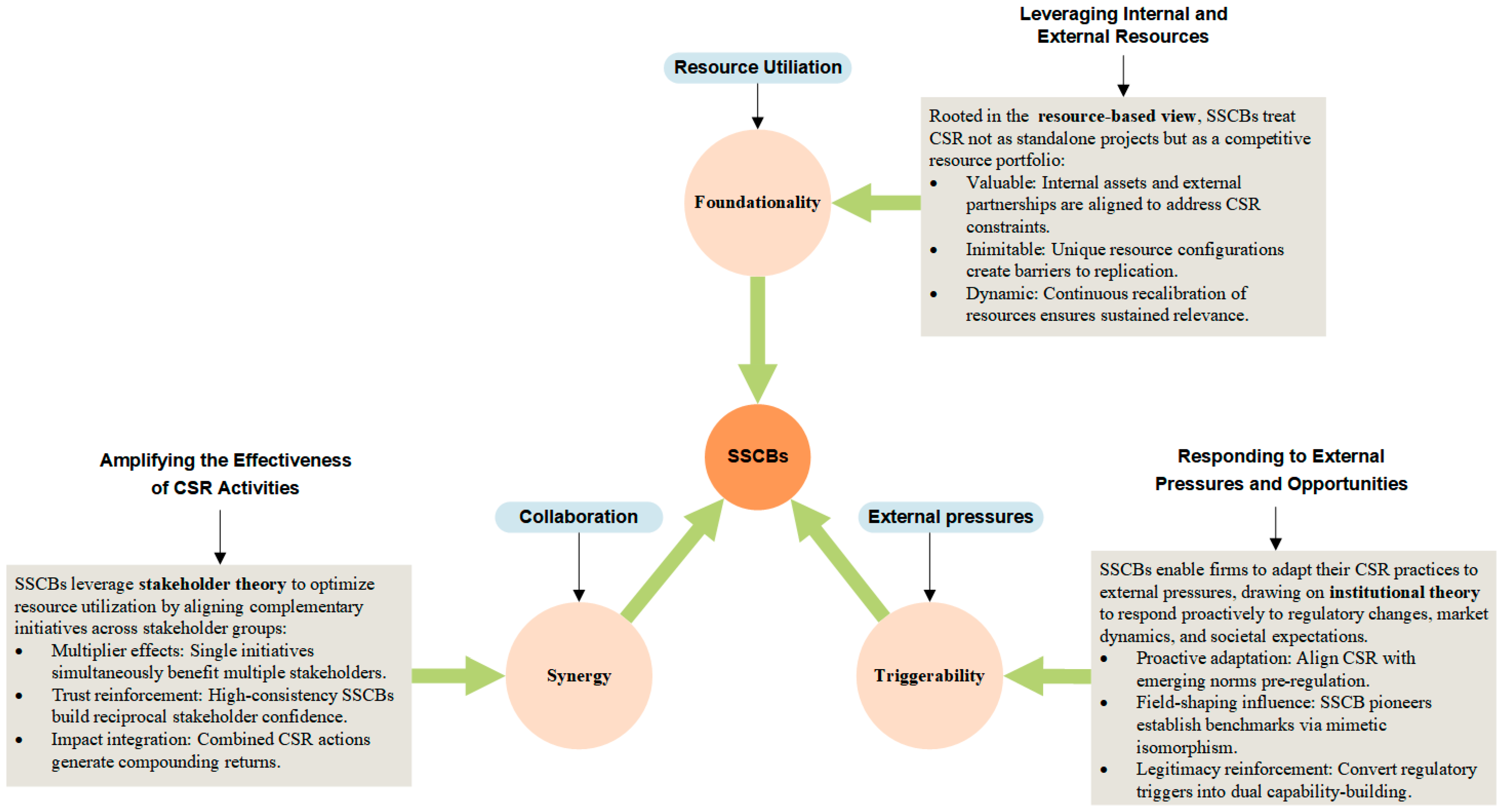

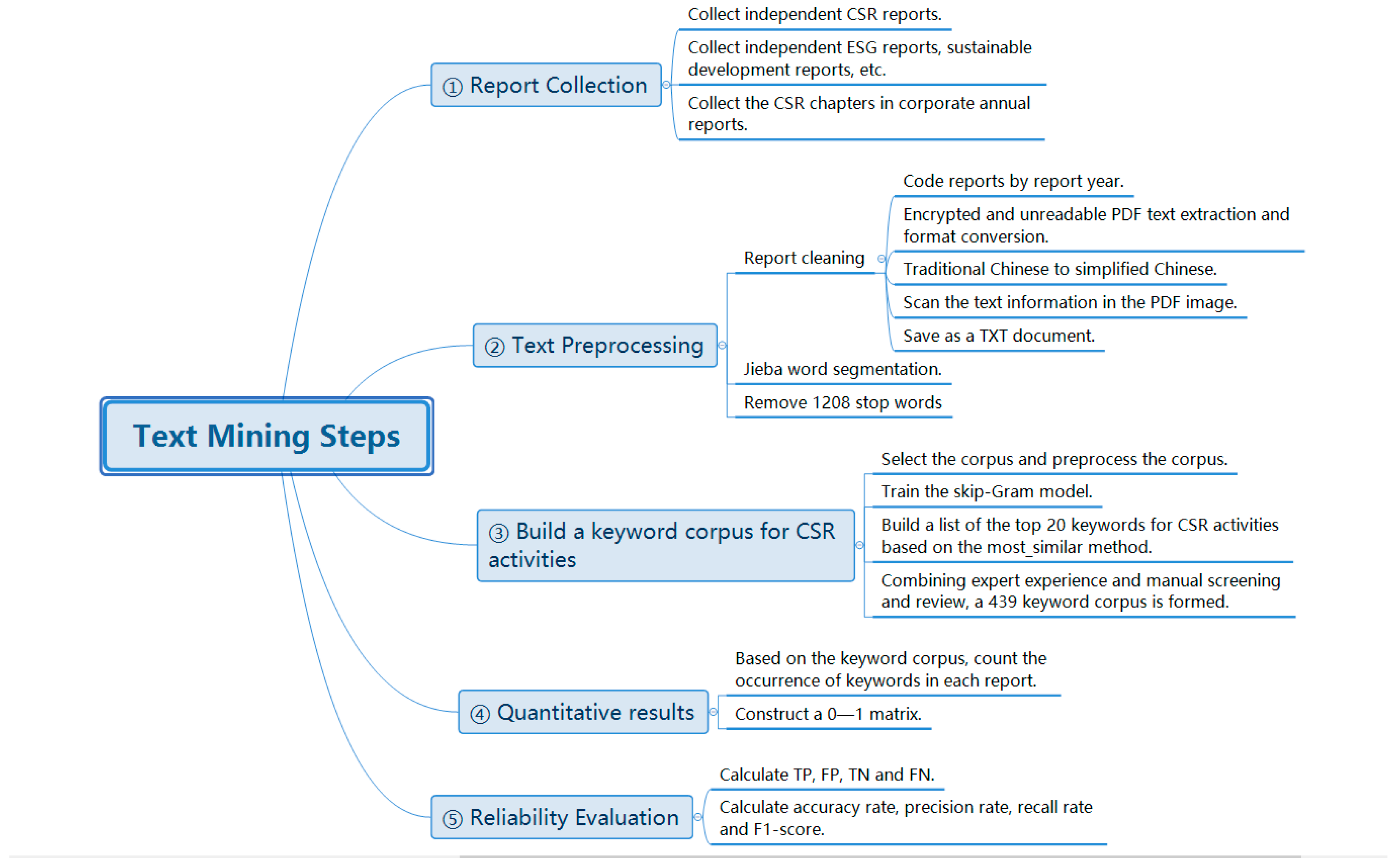

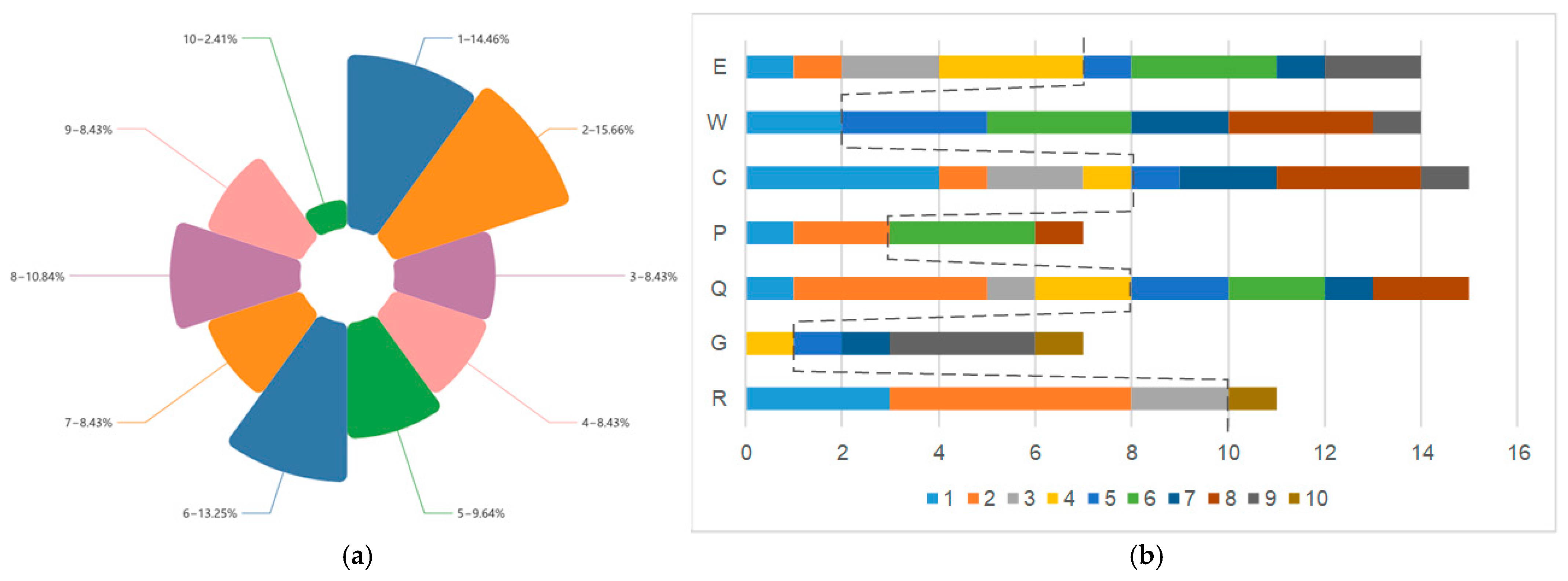
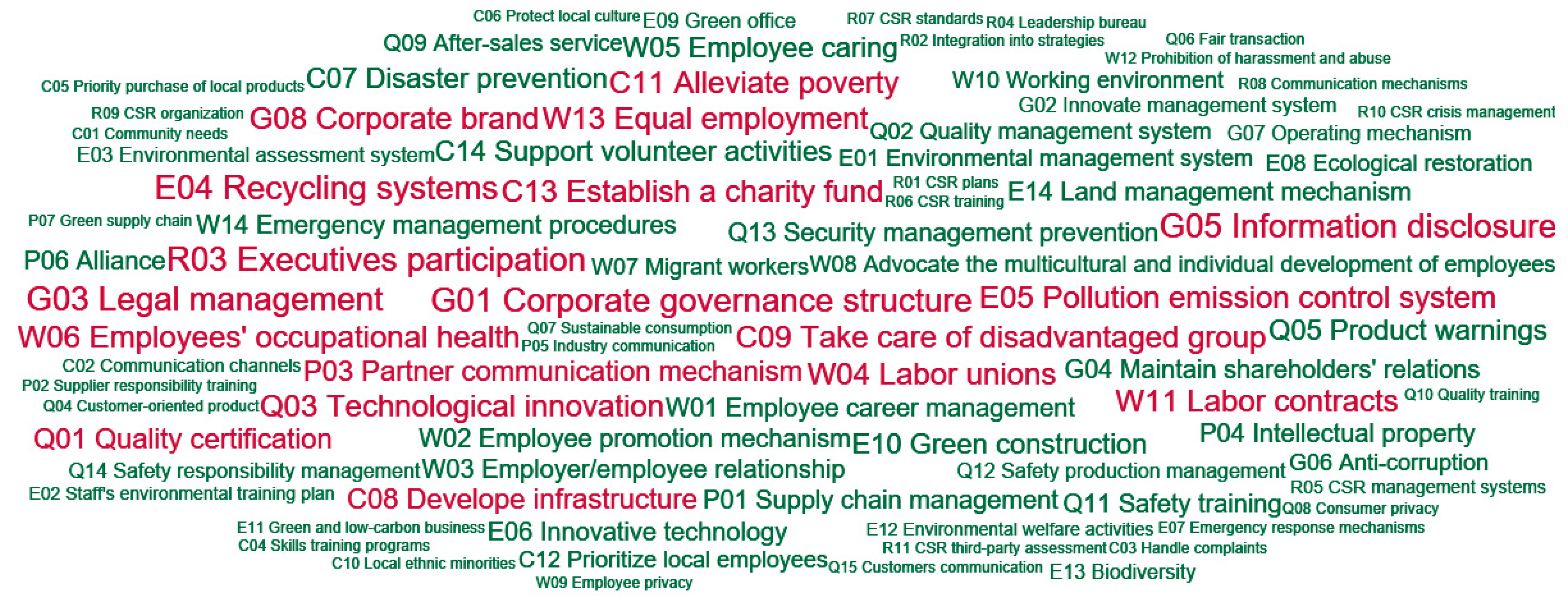
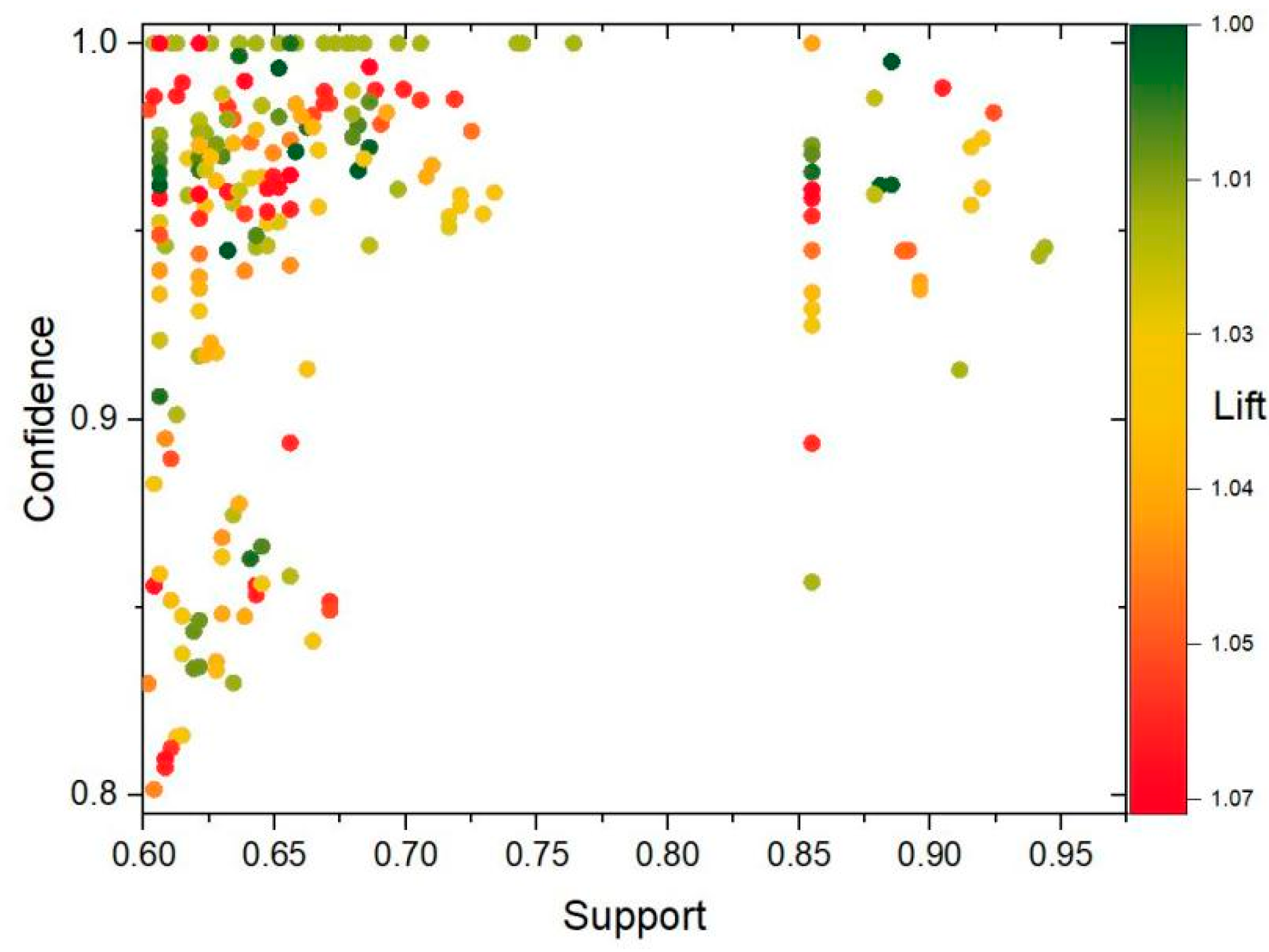
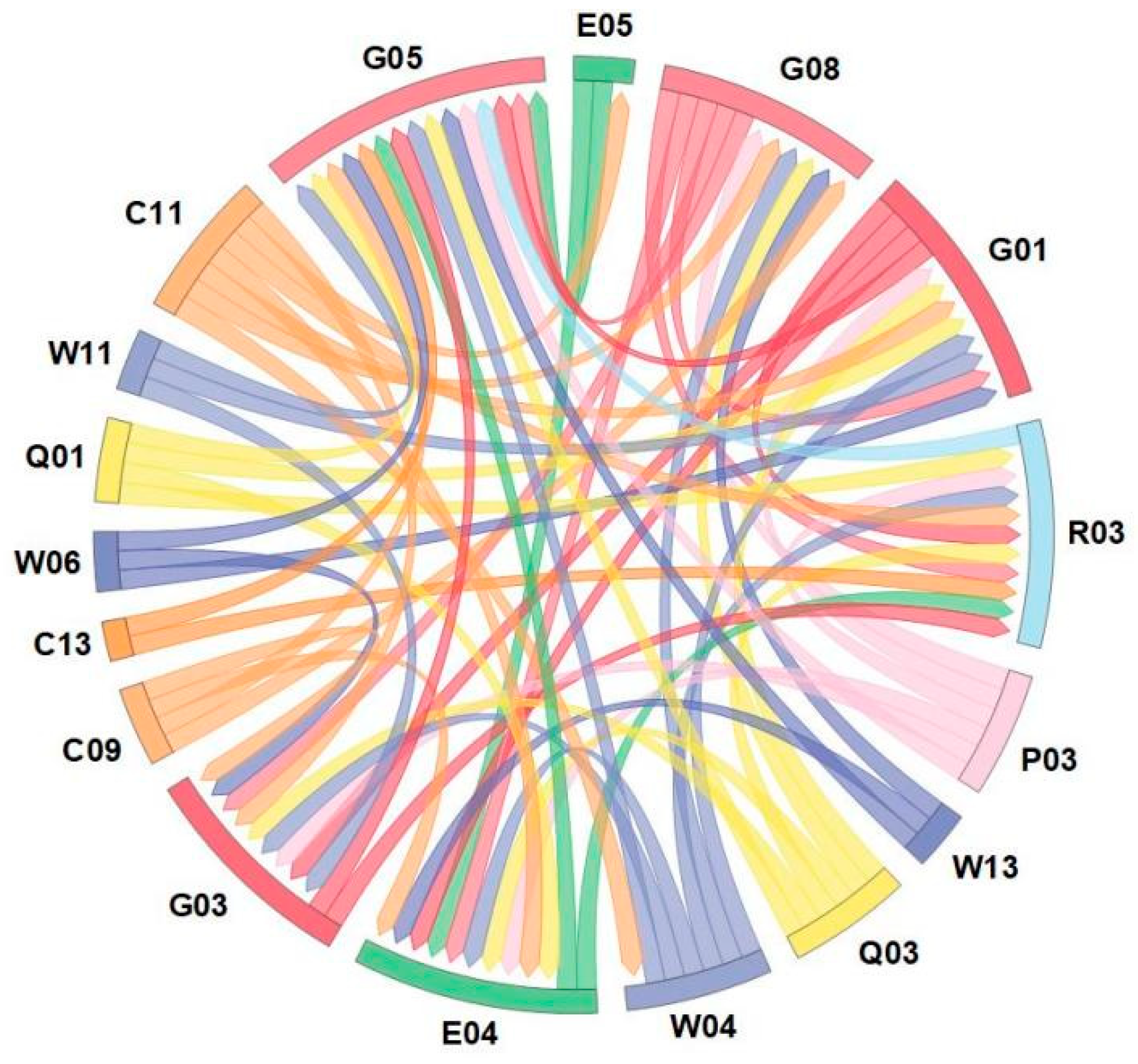
| Reliability Index | Equation | Validation Results |
|---|---|---|
| Accuracy | 97.24% | |
| Precision | 92.75% | |
| Recall | 79.34% | |
| F1-score | 0.874 |
| Dimensions | Definitions | No. of Behaviors | References |
|---|---|---|---|
| Management of Responsibility (R) | Management of responsibility (R) is the management of corporate social responsibility itself, including planning, formulating, and implementing social responsibility activities, establishing and organizing relevant departments, etc. [55]. | 11 | [11,18,23,56,57] |
| Corporate Governance (G) | Corporate governance (G) integrates CSR behavior into a firm’s day-to-day operations and management. It is the responsibility of the entire firm to determine the wide range of uses for which organizational resources will be deployed to the firm [58]. | 8 | [11,18,56,59,60] |
| Safe Construction and Quality (Q) | Safe construction and quality (Q) are the basic requirements of construction firms, including maintaining and improving the safety and quality of construction, reflecting the ability of construction units to safely deliver high-quality products [13]. | 15 | [11,13,56,61] |
| Good Partnership (P) | Good partnership (P) mainly involves responsibilities toward suppliers, competitors, and other associations and alliances. A responsible construction firm should be able to develop a better relationship with its supply chain and partnerships [62]. | 7 | [14,60,63,64,65] |
| Workers’ Interest (W) | Workers’ interest (W) is a responsibility concerning employees. It includes management issues such as employment policy, employment relations, workplace safety, and human development and training [66]. | 14 | [52,60,63,67] |
| Well-being of Local Community (C) | The well-being of the local community (C) consists of community engagement and development. Construction activities directly affect local communities and face issues such as resettlement, demolition, and construction [67]. | 14 | [13,24,52,60,65,68] |
| Environment Preservation (E) | Environment preservation (E) refers to the attention paid to and the protection of the environment throughout the entire life cycle of firms, including corporate offices, construction activities, and the post-operation and maintenance of buildings [69]. | 14 | [23,47,56,61] |
| Length of Itemset | -2- | -3- | -4- | -5- | -6- | Total No of Rules | |||||
|---|---|---|---|---|---|---|---|---|---|---|---|
| No. of Rules | 60 | 280 | 493 | 192 | 288 | ||||||
| Position | LHS | RHS | LHS | RHS | LHS | RHS | LHS | RHS | LHS | RHS | |
| G05 | 0 | 15 | 46 | 72 | 131 | 165 | 92 | 86 | 14 | 14 | 635 |
| R03 | 1 | 10 | 46 | 57 | 147 | 136 | 101 | 78 | 18 | 10 | 604 |
| G03 | 2 | 9 | 41 | 43 | 112 | 78 | 53 | 29 | 19 | 9 | 395 |
| E04 | 2 | 10 | 51 | 58 | 149 | 120 | 90 | 60 | 20 | 8 | 568 |
| G01 | 4 | 8 | 46 | 56 | 154 | 136 | 90 | 64 | 18 | 10 | 586 |
| G08 | 5 | 6 | 48 | 46 | 149 | 107 | 77 | 31 | 21 | 7 | 497 |
| E05 | 2 | 1 | 28 | 4 | 91 | 11 | 22 | 2 | 0 | 0 | 161 |
| W04 | 6 | 1 | 47 | 5 | 106 | 3 | 54 | 2 | 0 | 0 | 224 |
| C09 | 4 | 0 | 8 | 0 | 0 | 0 | 0 | 0 | 0 | 0 | 12 |
| Q03 | 6 | 0 | 44 | 0 | 100 | 1 | 14 | 0 | 0 | 0 | 165 |
| W13 | 3 | 0 | 3 | 0 | 0 | 0 | 0 | 0 | 0 | 0 | 6 |
| C11 | 7 | 0 | 48 | 1 | 69 | 0 | 15 | 0 | 0 | 0 | 140 |
| W06 | 3 | 0 | 0 | 0 | 0 | 0 | 0 | 0 | 0 | 0 | 3 |
| C13 | 2 | 0 | 0 | 0 | 0 | 0 | 0 | 0 | 0 | 0 | 2 |
| W11 | 3 | 0 | 6 | 0 | 0 | 0 | 0 | 0 | 0 | 0 | 9 |
| P03 | 6 | 0 | 27 | 0 | 7 | 0 | 0 | 0 | 0 | 0 | 40 |
| Q01 | 4 | 0 | 9 | 0 | 0 | 0 | 0 | 0 | 0 | 0 | 13 |
| C08 | 0 | 0 | 0 | 0 | 0 | 0 | 0 | 0 | 0 | 0 | 0 |
| Total No. | 60 | 60 | 498 | 342 | 1215 | 757 | 608 | 352 | 110 | 58 | / |
Disclaimer/Publisher’s Note: The statements, opinions and data contained in all publications are solely those of the individual author(s) and contributor(s) and not of MDPI and/or the editor(s). MDPI and/or the editor(s) disclaim responsibility for any injury to people or property resulting from any ideas, methods, instructions or products referred to in the content. |
© 2025 by the authors. Licensee MDPI, Basel, Switzerland. This article is an open access article distributed under the terms and conditions of the Creative Commons Attribution (CC BY) license (https://creativecommons.org/licenses/by/4.0/).
Share and Cite
Zhang, Y.; Zhang, Q.; Jiang, W.; Sang, M.; Ye, K. Super-Supportive Corporate Social Responsibility Behaviors in China’s Construction Enterprises. Buildings 2025, 15, 3587. https://doi.org/10.3390/buildings15193587
Zhang Y, Zhang Q, Jiang W, Sang M, Ye K. Super-Supportive Corporate Social Responsibility Behaviors in China’s Construction Enterprises. Buildings. 2025; 15(19):3587. https://doi.org/10.3390/buildings15193587
Chicago/Turabian StyleZhang, Yuqing, Qian Zhang, Weiyan Jiang, Meiyue Sang, and Kunhui Ye. 2025. "Super-Supportive Corporate Social Responsibility Behaviors in China’s Construction Enterprises" Buildings 15, no. 19: 3587. https://doi.org/10.3390/buildings15193587
APA StyleZhang, Y., Zhang, Q., Jiang, W., Sang, M., & Ye, K. (2025). Super-Supportive Corporate Social Responsibility Behaviors in China’s Construction Enterprises. Buildings, 15(19), 3587. https://doi.org/10.3390/buildings15193587






